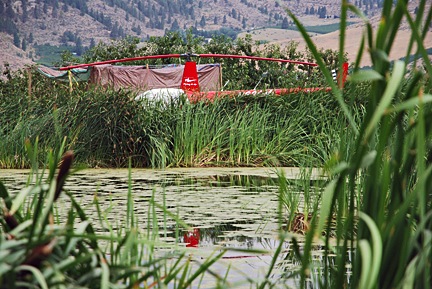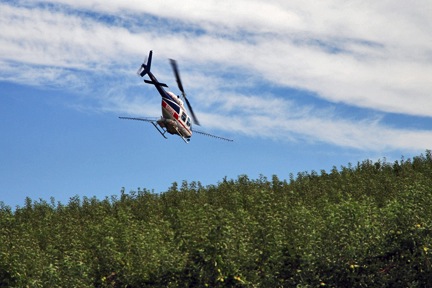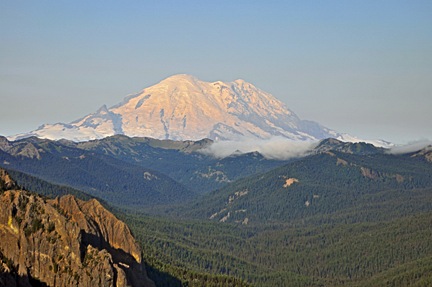Not all flying hours are equal.
A fellow helicopter pilot and I often debate the merits of the current system of pilot experience building.
In the U.S., a pilot generally gets his (or her) private, commercial, and CFI ratings, often picking up an instrument rating along the way. He then spends the next 500 to 1000 hours as a flight instructor, teaching other people how to fly under the close supervision of a chief flight instructor. With the golden number of hours — 1,000, for most helicopter pilot jobs — logged, the pilot goes on to an entry level position in a company where he’s closely supervised by a chief pilot who calls all the shots. Through the logging of time in various aircraft, the pilot works his way up to better-paying, more challenging jobs.

My helicopter, parked beside a pond in an orchard, waiting for rain during cherry season.
My friend and I didn’t follow this typical career path. Instead, we learned to fly, bought our own helicopters, and started our own flying businesses, learning through more varied experiences in a much shorter time. We both worked closely with the FAA to get our Part 135 certificates and pass annual check rides and inspections. And we generally agree that the hours we’ve logged are “worth” more than those logged by a typical pilot on the typical career path.
Now I know that the mere idea that all logged hours are not the same will bother a bunch of readers who are pilots on that typical career path. So I’ve decided to provide a comparative list of experiences based on real-life pilots so you can objectively consider my argument.
I recently had the opportunity to fly with two relatively new helicopter pilots. And a year ago, I flew with another one. I spent more than 14 hours of flight time with all three of them. Here’s how their experience stacks up against mine.
| Them | Me |
| All three of these guys had private, commercial, and certified flight instructor (CFI) endorsements. At least one also had an instrument rating and a CFII rating. | I only went through Private and Commercial helicopter training. I never became a CFI and although I started work on an instrument rating back in the beginning of 2008, I haven’t finished it. |
| All three of these guys had right around 300 hours of flight time. The vast majority of that time was in Robinson R22 helicopters — although I think one of them might have had most of his training in Robinson R44s because of his size. (He wasn’t fat, but he was very tall and with height comes weight.) Virtually all of their flight time was built with a CFI in the seat beside them, flying within 50 miles of the airport where they learned to fly. | I have about 2,100 hours of flight time these days, built in Robinson R22, Robinson R44, and Bell 206L helicopters, with a tiny bit of stick time in a Hughes 500 and a Bell 47. I’ve flown in nine states, including Arizona, New Mexico, California, Nevada, Utah, Colorado, Oregon, Washington, and Idaho. I’ve flown over deserts, mountains, lakes, forests, canyons, and coastlines. |
| All three of these guys built their flight time in basic and more advanced training. That’s 300 hours of hovering, flying traffic patterns, practicing autorotations, and performing other textbook maneuvers to textbook standards. They flew mostly during the day in good weather, at or near sea level. When (or if) these guys get jobs as CFIs, they’ll build their next 700 hours of flight time sitting in a seat beside a variety of student pilots, handing the controls only until the student can perform basic maneuvers without assistance. Then they’ll keep the student pilot out of trouble by being ready to get on the controls while daydreaming about their next flying job — the one that might actually pay them enough money that they can afford to pay their rent. | I built my flight time with about 200 hours of basic and advanced training followed by an enormous amount of cross-country flying — including far more solo flight time than the average pilot — and flights for hire. The for-hire flights include short rides, sightseeing tours, photo flights, aerial survey flights, video flights, air-taxi flights, wildlife survey flights, cattle spotting, and cherry drying. I’ve flown in perfectly clear daytime weather, under (and over) low clouds, around thunderstorms, through rain showers, and into the complete darkness of a remote desert night. I’ve landed on and off airports, from sea level to over 10,000 feet density altitude. |
| These guys have always flown under the close supervision of a CFI or chief flight instructor, following the rules laid down by their flight schools. Decision-making was likely limited to go/no go decisions that were likely based on conservative guidelines; in other words, if there’s a real go/no go decision to make, don’t go. | About 1/4 of my flight time was flown under the close supervision of a CFI, chief flight instructor, or chief pilot. The rest of it was flown under my own supervision. I made all the decisions that needed making, from how much fuel to load and where to seat the passengers to what route to take and where to stop for fuel to how to find my way around the unforecasted thunderstorm in my path. And go/no go, of course. |
| All three of these guys are qualified to teach student pilots how to fly helicopters. | I’m not. |
What bothers me most is that limited experienced pilots are the ones teaching people how to fly. Then, after logging hour after hour of doing the same thing in the same basic conditions, they’re more qualified for a job than someone else with “better” experience but fewer hours.
Is there something wrong with this situation?
I’m not complaining about not being able to teach. I don’t want to. I like life far too much to put it into the hands of someone who doesn’t know how to fly. I just question the wisdom of using our least experienced certificated pilots to teach non-pilots how to fly.

An experienced agriculture pilot sprays wax on Apple trees from a JetRanger in Washington state.
When I was an 800-hour pilot, it bothered me that a typical 1,000-hour pilot on the typical career path was considered more experienced than I was. I was willing to prove that I was an as good — if not better — pilot than he was, but no one wanted to give me the opportunity. Sure, he can do autorotations better than I could — after all, he’d been doing them every day for much of his 1,000 hours of flight time. But how was he on off-airport landings? Planning cross-country flights? Landing at unfamiliar airports? Flying around or under or through weather? Managing power with a full load of full-sized passengers at high density altitude? Simply feeling the aircraft as an extension of his body that gave him the ability to fly?
That’s water under the bridge now. I’ve built my time and now qualify for a wide range of jobs. And if I get my CFI — which I expect to this winter — I could probably be a pretty good flight instructor.
But for now, I’ll just continue on my own career path. It may not be typical, but it’s challenging. And every flight offers the possibility of a real learning experience.




